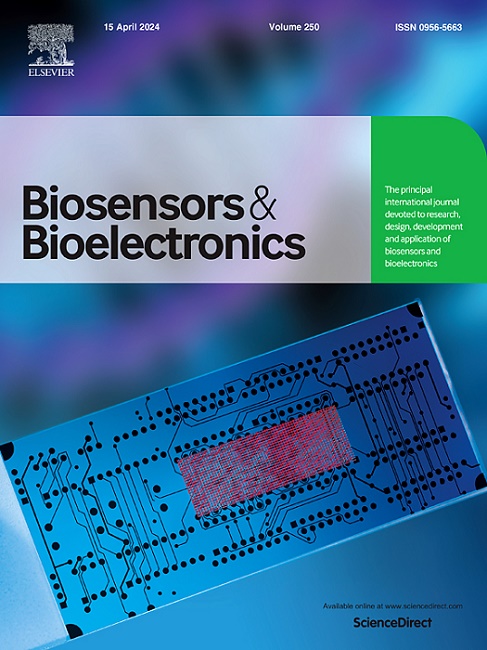一种食源性细菌病原体的单管检测。
IF 10.5
1区 生物学
Q1 BIOPHYSICS
引用次数: 0
摘要
及时和可靠地检测食源性细菌病原体对于减轻低收入和中等收入国家的疾病负担至关重要。然而,在资源有限的环境中,往往无法获得基于实验室的方法。在这里,我们开发了一种单管试验和一种低成本的手掌大小的装置,用于现场检测具有代表性的食源性细菌病原体肠炎沙门氏菌。我们的分析结合了蛋白质-核酸信号转导、指数扩增反应(EXPAR)和聚集规律间隔短回文重复序列(CRISPR)/CRISPR相关12a (Cas12a)的优势。在系统地研究了这些组分的相容性后,我们开发了一种“三合一”整合反应,称为ST-EXPAR-CRISPR测定。该检测只需要一根试管,控制温度(39°C),操作简单,无需细菌分离,核酸提取或洗涤步骤。ST-EXPAR-CRISPR检测能够检测低至37 CFU/mL的目标细菌。使用我们的工具包和便携式设备,未经训练的志愿者成功地检测了户外食品样品中的污染。检测过程的简单性和最小的硬件要求使我们的分析在护理点和现场场景中的应用非常有前途。此外,ST-EXPAR-CRISPR检测方法可以通过改变核酸序列来检测其他靶标,且研发成本低,有可能减轻全球疾病负担。本文章由计算机程序翻译,如有差异,请以英文原文为准。

Single-tube detection of a foodborne bacterial pathogen using user-friendly portable device
Timely and reliable detection of foodborne bacterial pathogen is crucial for reducing disease burden in low- and middle-income countries. However, laboratory-based methods are often inaccessibility in resource-limited settings. Here, we developed a single-tube assay and a low-cost palm-sized device for on-site detection of the representative foodborne bacterial pathogen, Salmonella Enteritidis. Our assay incorporates the advantages of protein-nucleic acid signal transduction, EXPonential Amplification Reaction (EXPAR), and clustered regularly interspaced short palindromic repeats (CRISPR)/CRISPR-associated 12a (Cas12a). After systematically investigating the compatibility of these components, we developed a “three-in-one” integration reaction, termed ST-EXPAR-CRISPR assay. This assay requires only one tube, one controlled temperature (39 °C) and simple operation, eliminating the need for bacterial isolation, nucleic acid extraction, or washing steps. ST-EXPAR-CRISPR assay is capable of detecting as few as 37 CFU/mL of target bacterium. Using our kit and portable device, untrained volunteers successfully detected contamination in food samples outdoors. The simplicity of the detection process and minimal hardware requirements make our assay highly promising for application in point-of-care and on-site scenarios. Moreover, the ST-EXPAR-CRISPR assay can be easily modified to detect other targets by changing the nucleic acid sequence with low research and development cost, potentially reducing the global disease burden.
求助全文
通过发布文献求助,成功后即可免费获取论文全文。
去求助
来源期刊

Biosensors and Bioelectronics
工程技术-电化学
CiteScore
20.80
自引率
7.10%
发文量
1006
审稿时长
29 days
期刊介绍:
Biosensors & Bioelectronics, along with its open access companion journal Biosensors & Bioelectronics: X, is the leading international publication in the field of biosensors and bioelectronics. It covers research, design, development, and application of biosensors, which are analytical devices incorporating biological materials with physicochemical transducers. These devices, including sensors, DNA chips, electronic noses, and lab-on-a-chip, produce digital signals proportional to specific analytes. Examples include immunosensors and enzyme-based biosensors, applied in various fields such as medicine, environmental monitoring, and food industry. The journal also focuses on molecular and supramolecular structures for enhancing device performance.
 求助内容:
求助内容: 应助结果提醒方式:
应助结果提醒方式:


